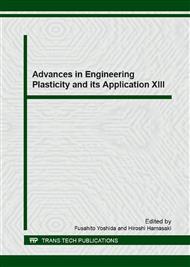p.82
p.88
p.94
p.99
p.105
p.110
p.116
p.122
p.127
The Saturated Impulse for Fully Clamped Square Plates Subjected to Linear-Decay Pressure Pulse
Abstract:
Saturated impulse refers to the critical value beyond which the deflection of the beam or plate under pulse loading will no longer increase with further applied load. Previous effort has been made to study the saturate impulse for structures under rectangular pressure pulse loading. Through theoretical analysis, the present paper investigates the saturated impulse for fully clamped square plates subjected to linear-decay pressure pulse, which is closer to explosive loading pulse. The results indicate that the saturated impulse does exist if the decay duration is greater than a certain value (i.e. the minimum decay duration). The saturated impulse, saturated deflection and saturated duration all have nonlinearly relations with the dimensionless applied pressure, and grow with the increase of the decay duration.
Info:
Periodical:
Pages:
105-109
Citation:
Online since:
December 2016
Authors:
Price:
Сopyright:
© 2017 Trans Tech Publications Ltd. All Rights Reserved
Share:
Citation:


